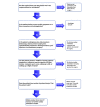A Redesigned Order Entry System for Reducing Low-Value Preprocedural Cardiology Consultations: Quality-Improvement Cohort Study
- PMID: 33393916
- PMCID: PMC7709841
- DOI: 10.2196/17669
A Redesigned Order Entry System for Reducing Low-Value Preprocedural Cardiology Consultations: Quality-Improvement Cohort Study
Abstract
Background: Preprocedural cardiac evaluation is a common reason for outpatient cardiology visits. Many patients who are referred to cardiology clinics for preprocedural evaluation are at low risk of perioperative events and do not require any further management. Our facility treats patients over a large geographic area; avoiding low-value consultations reduces time and travel burdens for patients.
Objective: Our study objective was to assess the impact of a novel algorithm in the electronic order entry system aimed to guide clinicians toward patients who may benefit from cardiovascular referral.
Methods: We retrospectively reviewed in-person consultations and electronic consultations (e-consults) to our cardiology service before and after implementation of the novel algorithm to assess changes in patterns of care. Data were stored in a custom electronic database on internal servers.
Results: We reviewed 603 consultations to our cardiology clinic and found that 89 (14.7%) were sent for preprocedural evaluation. Of these, 39 (43.8% of preprocedural consultations) were e-consults. After implementation, we reviewed 360 consultations. The proportion of consultations for preprocedural evaluation did not decrease (n=47, 13.0%; P=.39). We observed an absolute increase of 13.6% in the proportion of consultations ordered as e-consults (27/47, 57.4%). During the postintervention period, we received no remarks, concerns, or criticisms from ordering clinicians about the process change and no reports of adverse events.
Conclusions: Implementation of an ordering algorithm to reduce low-value preprocedural cardiology evaluations did not lead to a reduction in the number of overall preprocedural cardiology consultations. The number of patients seen electronically increased, potentially improving clinic access and reducing travel burden for patients.
Keywords: medical order entry systems; preoperative care; quality improvement.
©David E Winchester, Leigh Cagino. Originally published in JMIR Perioperative Medicine (http://periop.jmir.org), 01.05.2020.
Conflict of interest statement
Conflicts of Interest: None declared.
Figures
References
-
- Fleisher LA, Fleischmann KE, Auerbach AD, Barnason SA, Beckman JA, Bozkurt B, Davila-Roman VG, Gerhard-Herman MD, Holly TA, Kane GC, Marine JE, Nelson MT, Spencer CC, Thompson A, Ting HH, Uretsky BF, Wijeysundera DN. 2014 ACC/AHA guideline on perioperative cardiovascular evaluation and management of patients undergoing noncardiac surgery: executive summary: a report of the American College of Cardiology/American Heart Association Task Force on Practice Guidelines. Circulation. 2014 Dec 09;130(24):2215–45. doi: 10.1161/CIR.0000000000000105. - DOI - PubMed
-
- Eysenbach G, CONSORT-EHEALTH Group CONSORT-EHEALTH: improving and standardizing evaluation reports of Web-based and mobile health interventions. J Med Internet Res. 2011;13(4):e126. doi: 10.2196/jmir.1923. http://www.jmir.org/2011/4/e126/ - DOI - PMC - PubMed
-
- Holt NF. Perioperative cardiac risk reduction. Am Fam Physician. 2012 Mar 01;85(3):239–46. http://www.aafp.org/link_out?pmid=22335263 - PubMed
Grants and funding
LinkOut - more resources
Full Text Sources


